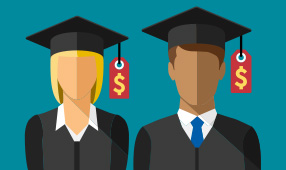Student debt is a hot topic in Washington as the administration looks for other ways to cancel student loans after the U.S. Supreme Court struck down the administration’s original plan to cancel up to $400 billion of the loans. The court ruled in a 6-3 vote in June 2023 that the government must seek congressional authorization for such a broad move. The suspension of student loans for the coronavirus pandemic ended with the ruling and repayments fell due again 60 days later.
Almost one-third of American students go into debt to graduate from college, and total student loan debt as of the third quarter 2023 was $1.74 trillion in federal and private loans, according to the U.S. Federal Reserve. Federal student loan debt makes up about 90 percent of the total, with households owing an average $37,645 in the third quarter of 2023, according to the Department of Education.
In February 2024, the administration announced cancellation of $1.2 billion in student debt for 153,000 borrowers enrolled in the Saving on a Valuable Education (SAVE) repayment plan. The debt forgiveness applies to borrowers who have been in repayment for at least 10 years who took out $12,000 or less in student loans. The new debt cancellation brought total student loan debt cancellation during the administration to $138 billion for 3.9 million borrowers, mostly in already existing programs limited to specific categories of borrowers.
Aside from the debt forgiveness proposal, many student loan holders may qualify for full or partial forgiveness, or favorable loan repayment options, including those who work in public-service fields such as education.
Start by checking your NEA student loan forgiveness options
The NEA Student Debt Navigator is a very popular membership benefit that can help you identify options that can reduce or eliminate some or all of your student loan debt obligations.
As a member of the National Education Association (NEA), you can run your numbers through the free-to-use interactive calculator tool to see what you might be able to save and what refinancing or forgiveness programs could suit your situation.
In addition to forgiveness options, the White House also announced plans to expand income-driven repayment (IDR) plans to help make student loan debt repayment more affordable for current and future borrowers, especially those with lower incomes. The NEA Student Debt Navigator can help you explore these IDR options as well.
And if you need further assistance, you can access student loan experts at our partner Savi via telephone or email through the tool.
Filing your paperwork electronically can help reduce errors and speed up the process of getting you into a refinancing or forgiveness program that can save you money. Savi can populate your information in the official application, and if you do choose to e-file through the platform, you can file for free the first year and get a steep discount in subsequent years as an NEA member.
You can find out more about how the NEA Student Debt Navigator works and see how it’s helping tens of thousands of NEA members significantly reduce their student loan debt.
Big savings are possible for those who qualify
One path to loan forgiveness is the Public Service Loan Forgiveness (PSLF) program. It’s important to note that this program kicks in only after 120 payments—that is, after 10 years. It went into effect in 2007, so the first actual forgiveness window started in October 2017. The standard loan repayment program pays down the loan in 10 years, so to benefit from forgiveness under PSLF, a borrower would have to lower payments by enrolling in an income-driven repayment (IDR) plan or some other form of extension.
As part of the Covid-19 student loan relief, however, debtors can get credit for monthly payments even during the suspension, as if they had actually continued to make payments. The option to get a refund to payments you did make ended on August 28, 2023.
In 2012, the U.S. Department of Education introduced a voluntary Employment Certification Form (ECF) so that borrowers can keep track of whether they will qualify for loan forgiveness under PSLF. The process and reporting were modified during the Covid-19 pandemic to simplify the form submission and provide additional data.
There are other options available to teachers for loan forgiveness, and exploring them will be well worth your time. Such options are extended to teachers because it’s forecast that the United States will need hundreds of thousands of educators to replace retiring baby boomers, and the profession’s average starting salary is $41,770, as of the 2020-21 school year, according to NEA.
For instance, as an educator, you can have as much as $17,500 of a subsidized or non-subsidized loan forgiven through the federal Teacher Loan Forgiveness program.
This applies to the William D. Ford Federal Direct Loan (Direct Loan) Program and the Federal Family Education Loan program (FFEL Loan), whether subsidized or unsubsidized. You’re eligible if you’ve been teaching full-time in a low-income elementary or secondary school, or an educational service agency, for five consecutive years.
A word of caution: As a rule, you can’t count a period of time for both Teacher Loan Forgiveness and Public Loan Forgiveness.
There are other special circumstances that can result in a loan being forgiven, canceled or discharged—all of which means the loan doesn’t have to be repaid, according to the Education Department. These include a total and permanent disability and, in certain cases, bankruptcy.
Short of loan forgiveness, an IDR plan such as the Saving on a Valuable Education (SAVE) plan sets a borrower’s monthly payment at a fixed percentage of your income so that payments become more manageable. As your income rises, your monthly payments will go up accordingly.
How to claim your student loan forgiveness
To be considered for any forgiveness option, you must go through your student loan servicer and indicate which option you’re interested in. You’ll need to complete all paperwork and follow-through, including forms that your employer must sign.
- If you’ve taught at different schools, you’ll have to have each one sign off on the application.
- If you have multiple loans with different companies, you have to complete the same process for each one.
But just think of the potential savings you could reap as a result. A borrower who graduated with $30,000 in debt and currently pays about $350 a month (a typical cost) would end up spending nearly $42,000 over 10 years to resolve the loan, according to estimates by Robert Farrington, founder of The College Investor. With $17,500 forgiven, the monthly payment would shrink to $248 after the fifth year. The borrower would only spend $14,900 on the original $30,000 loan, which is a huge savings.
“It can get complex, but it’s worth it,” Farrington says. “You never want to walk away from ‘free’ money!”
One more option to ease your payments
Even if you can’t take advantage of student-loan forgiveness programs, you still may be able to reduce the interest rates on your loans. There aren’t any federal programs that can lower them, but many student loan-servicing companies offer incentives to do so.
Signing up for automatic payments, for instance, can get a reduction in rates because the servicer is assured of getting the monthly payment on time. This normally can reduce the interest rate by 0.25%, with some lenders giving as much as 0.50% off. Some lenders also offer an additional loyalty discount.
You can get more information about federal loan-forgiveness options from the Federal Student Aid site.
The Consumer Financial Protection Bureau offers a student-loan debt toolkit for teachers and other public servants.









